Laying the Groundwork
[Not] starting slow to go fast is where we often fall down in our quality projects.
– Chief Medical Officer
When working toward such an ambitious goal, just figuring out where to start can feel overwhelming. Before diving into training curricula or working out lab logistics, it’s important to take a step back and survey the overall organizational environment. Organizational change cannot be accomplished without establishing some key, high-level pillars to support the massive effort.
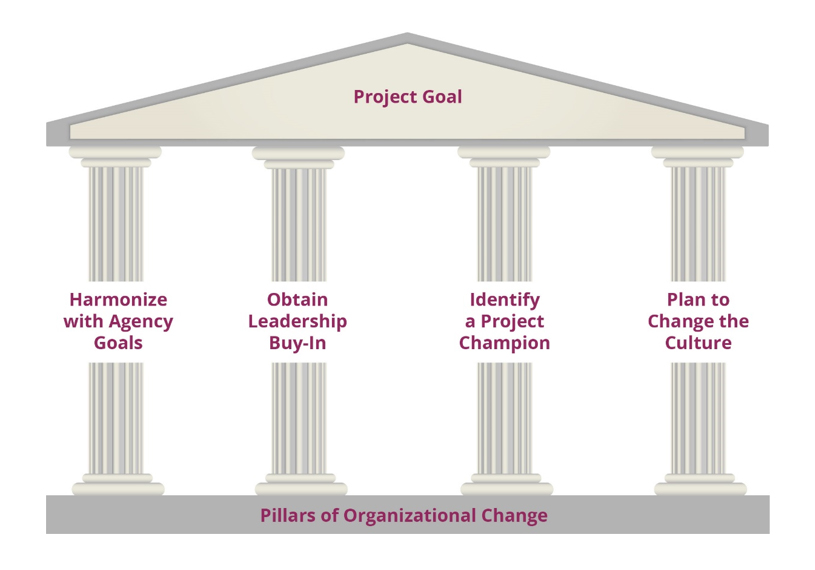
Harmonize with Agency Goals
Aligned incentives are a magic dust on these sorts of projects.
– Chief of Psychiatry and former Medical Director, Brookwood site
At Santa Rosa Community Health, our HIV testing project benefited from an overall organizational goal of increasing the use of quality metrics. In turn, subsequent screening efforts have grown from the example we set through this project.
Think about how this project fits in with all the other priorities and projects at your organization. Take one more step back and think about how it aligns with your overall mission. Projects that don’t align with organizational goals and compete with other priorities will struggle. Here are a few things to think about:
- What is your organizational mission? Is integrating HIV testing for all patients a good fit? Explaining how it fits can help motivate others to support the project.
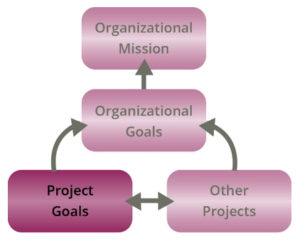 What are the organization’s larger goals? Is it trying to become a more data-driven organization, or focusing on improving its approach to team-based care? How would spending organizational resources to test all patients for HIV reinforce these wider goals? Being able to explain how it does can help motivate others to support the project.
What are the organization’s larger goals? Is it trying to become a more data-driven organization, or focusing on improving its approach to team-based care? How would spending organizational resources to test all patients for HIV reinforce these wider goals? Being able to explain how it does can help motivate others to support the project.- What other projects are currently underway or in the planning stages? How does HIV testing for all patients align with the goals of those projects? How would it align with any efforts or changes required by them? Explaining how the project converges with other priorities, how it might even contribute to their successes, can help convince others to support it.
Projects that align with mission, goals, and other projects are primed for success. It just takes communicating with everyone, from leadership to front-line staff, exactly how the project fits in.
Obtain Leadership Buy-In
It’s very relational.
– Chief Medical Officer
At Santa Rosa Community Health, achieving higher HIV screening rates resulted from healthy support and participation from clinic leaders. The many systemic changes we made would not have been possible without that support, achieved through significant early reconnaissance and communication. Here are a few things to try when garnering leadership buy-in:
- Focus on all the ways the project harmonizes with other organizational goals and projects to convince leaders that it aligns with them and may even contribute to their success.
- Approach leaders throughout the organization. The Chief Operating Officer and Chief Medical Officer’s support are critical but many other leaders can affect its success:
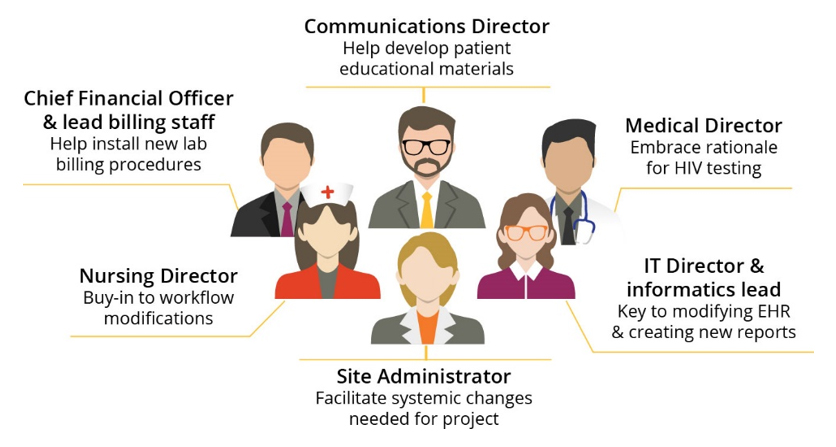
- Obtain all this buy-in systematically. Start with a single relationship with a key leader who can provide guidance on how to navigate through the organization. Then reach out to the next level of leaders, followed by talking with every single site, and then working your way out to managers and finally the providers themselves. At the site and provider level, focus on the importance of the project and the support they’ll receive to achieve testing goals. You might benefit from talking with a few patients, whose perspective can inform your talks with clinic leaders. Talking to a wide range of people can also keep you from alarming any key staff or accidentally usurping others’ pet projects.
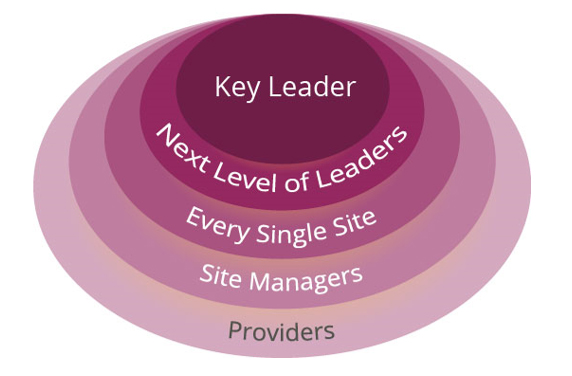
- Keeping the attention of leadership is key. Look for opportunities to embed it into existing leadership meetings and other types of agency communications. Updating leaders on project progress and showcasing the project’s goals and needs for support in the public setting of a meeting can help move them from passive observation to active advocacy for the project’s success.
- Be mindful of your expectations for leadership support of the project. There’s a limit to how much time they have to actually work on the project. Discuss with them whether they want to be invited to meetings. Don’t expect their mere presence in the room to get everyone to do the work- the project itself needs to develop its own stature in order to succeed.
Projects that align with mission, goals, and other projects are primed for success. It just takes communicating with everyone, from leadership to front-line staff, exactly how the project fits in.
Identify a Project Champion
As a new person, [our project champion] struggled at first to have credibility with staff but eventually won them over through persistence, many in-person appearances, a non-judgmental attitude, and incentives.
– Senior Nurse Manager
An ambitious project that spans the organization needs buy-in from leadership, but it also requires an individual, small group or committee to champion it, to oversee its progress and take the lead on problem-solving when barriers are encountered.
At Santa Rosa Community Health, the grant we received enabled us to hire an HIV Testing Training Specialist who spent 100% of her time leading the project. She attended leadership meetings, trained staff, facilitated the creation and distribution of data reports, and helped modify workflows and customize EHR settings. In addition, she was accessible to everyone; posters and fliers contained her contact information, and staff could reach her with a quick phone call.
Not every organization will be lucky enough to have a full-time champion, but change is still possible if at least one person takes the lead on knowing what’s happening and communicating it across the organization. In these situations, the higher the champion sits on the organizational chart, the greater the likelihood for success. But regardless of their position, keeping the project on everyone’s collective radar may be enough to generate forward progress.
Plan to Change the Culture
You can get tripped up on assumptions. You need to look at the assets and liabilities of each individual site. The culture is different in each one. The microenvironment matters. It adds complexity. We did HIV testing in a standardized way across all the sites but the microclimate still made a difference.
– Chief Medical Officer
Attend meetings to communicate with others but also to understand competing priorities. For example, at Santa Rosa Community Health, the project champion attended regular cross-operations leadership meetings, and joined the Communications Committee, a cross-functional agency-wide committee formed to create more effective communication strategies. Attendance at these meetings gave her insights into organizational priorities, helping her to frame the HIV testing project in alignment with those competing priorities.Accomplishing opt-out HIV testing across all areas of an organization requires a cultural shift in how staff and patients think about HIV and what they understand about testing, prevention, and treatment. Cultural change requires planning and persistence, and wherever possible, work to embed the project into existing culture and systems. Here are a few strategies for taking it on:
- Coordinate with other competing efforts. In a clinic environment, no one has enough resources or time. Wherever you can coordinate efforts with other projects, you increase the chances for success. For example, consider combining training on HIV testing with other required trainings. Streamlining efforts like this make it easier for everyone. It can also foster stronger relationships across the agency between training and communication efforts that would otherwise remain siloed.
- Where current organizational structure is lacking, consider creating new structure. Just be sure it stays aligned with overall organizational goals. For example, our efforts to integrate HIV Testing training into other agency-wide training efforts led to the development of a Training Collaborative Committee that works to harmonize and coordinate such efforts.
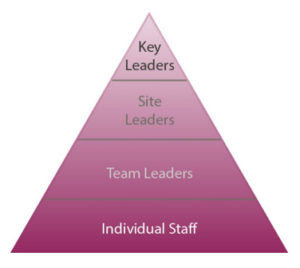 Keep all levels of organizational culture in mind as you approach the project, from the key leadership of the organization, to the site leaders, team leaders, and all individual staff. Wherever possible, your goal should be to embed the project into existing systems and culture at each of these levels.
Keep all levels of organizational culture in mind as you approach the project, from the key leadership of the organization, to the site leaders, team leaders, and all individual staff. Wherever possible, your goal should be to embed the project into existing systems and culture at each of these levels.- Don’t make assumptions about sites or people. Sites that serve the highest risk, most complicated patients may seem like poor candidates for implementation because they have so many other problems to deal with, but they may actually be the most motivated because their patients have the most to gain. A site that’s very well managed may seem like the logical place to start, but if their patient population largely consists of low risk families, they may prioritize chronic disease management over HIV testing.
![$logo['alt']](https://srhealth.org/wp-content/uploads/2017/03/srch-logo-1.png)